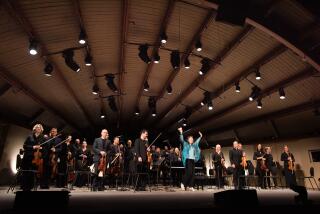Dance : Eiko and Koma’s ‘Wind’ Rises Above Their ‘Land’
- Share via
Downy feathers float from the ceiling to the stage of Schoenberg Hall a few at a time, forming a carpet that gleams like fresh snow yet continually drifts and eddies like sand under the sea.
A man standing at the side of this luminous, moving space slowly stretches back a wooden bow and shoots an arrow diagonally across the stage into the wings--an action that sets in motion a remarkable work, and weekend, with Eiko and Koma Otake, a wife-and-husband team famed for intense, poetic interaction with elements of nature.
In “Wind” (1993) on Friday at UCLA and “Land” (1991) on Saturday at the Japan America Theatre, these Japanese-born performing artists collaborate with Native American composer Robert Mirabal and lighting designer Jeff Fontaine, but these one-act, 70-minute pieces (both local premieres) differ greatly in approach and impact.
Where “Wind” remains mercurial and inspired, “Land” seems comparatively literal and often distressingly obvious. Even its gorgeous Mirabal score (for percussion, flute and voice) often proves a distraction--pulling attention away from the movement images, while the eclectic taped accompaniment for “Wind” bathes and tints the stage action with great delicacy.
Performed against a giant canvas by Sandra Lerner that evokes the red canyons of the Southwest, “Land” is about survival in a specific landscape. As they painfully crawl and slide around and across one another in a brilliant initial duet that turns out to be the only indelible segment of the piece, Eiko and Koma suggest non- or pre-human creatures of the dust: eyeless, legless, colorless and in constant motion out of fierce need.
After that, however, only the music (performed by Mirabal and Reynaldo Lujan) keeps its edge. A solo for Koma involves his dragging a buffalo carcass--as if auditioning for a Sierra Club protest poster. A solo for Eiko finds her struggling to stand and walk but always collapsing--butoh Expressionism standard enough to be predictable. Their 6-year-old son Shin makes an appearance but has no real place in the piece and the oh-so-sensitive finale comes out of nowhere.
If you’ve never seen Eiko and Koma, the sheer performing prowess on view in “Land” can be a revelation: watching Eiko desperately claw the dirt and distractedly clutch at dead branches, for example, or Koma hurl himself into a knee-drop with suicidal force.
Happily, “Wind” showcases their artistry no less impressively, but with a conceptual purity that makes everything fit--including Shin. The arrow launched in the first scene becomes a talisman, borne mournfully as a symbol of human violence and pain.
Recordings of 16th-Century choral music by Francisco Guerrero reinforce the depictions of suffering but, before long, Koma’s fingers are tracing patterns in the downy layer on the floor and Eiko is lying on her back in it, limbs slowly swirling as if she’s immersed in water or is now an undersea plant.
Becoming one with nature emerges in “Wind” as a means of transcending human violence, with a climactic nude duet (accompanied by a bagpipe drone) representing an embrace of the Earth as much as an expression of need for one another. The lesson is passed on to Shin in the last scene: a benediction of the arrows for the next generation.
But beyond its meanings, “Wind” derives an almost magical aura from the art of stillness. It’s like looking at clouds: Nothing really moves, yet if you look away or grow lost in thought, everything changes. Filled with feeling, the slow-motion dance-poetry of Eiko and Koma can suspend time or at least reduce the relentless tick-tick-tick of our lives to the pace of downy feathers drifting downward.
The Japan America Theatre and UCLA are part of the network of presenters that commissioned “Wind.” No additional local performances have been announced.
More to Read
The biggest entertainment stories
Get our big stories about Hollywood, film, television, music, arts, culture and more right in your inbox as soon as they publish.
You may occasionally receive promotional content from the Los Angeles Times.










